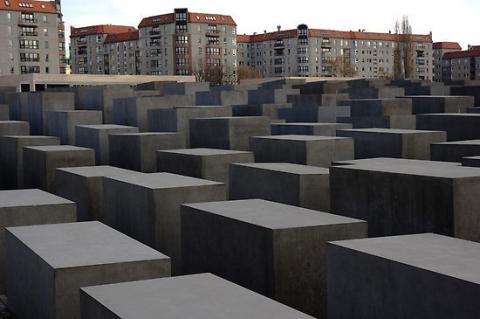The Holocaust endures in German politics

You feel nothing like the initial awe you get in front of Picasso’s Guernica in the Reina Sofia museum in Madrid. The initial impression at Berlin’s Holocaust Memorial is of blandness.
But the memorial was not designed to be looked at; it was designed to be experienced, to be walked through, through the lines of those 2,711 slabs of dark grey concrete, arrayed in a grid on a sloping surface.
As you walk through alone (the narrow corridors don’t allow two people to walk side by side),there is a sense of menace in the order of the concrete slabs, which are more like rectangular pillars as you get into the memorial.
You get a feeling of the vastness of it all, the deliberateness of it all, the ordered awfulness. The longer you walk, the more overwhelming it becomes - or, at least, that was my experience last Sunday.
There have been raging controversies about the memorial. First, the absence of representation was a disappointment to many when the memorial opened in 2005. Also, the fact that it memorialised only Jews who had been murdered in the Holocaust annoyed people; there was also no acknowledgment that gay men and women were murdered, along with Roma, disabled people and Communists.
Then there was the deeply disturbing revelation that the chemical firm which had supplied the Nazis with Zyklon B gas to poison the herded masses in the chambers had been contracted to provide an anti-graffiti substance to spray on the memorial’s slabs.
The company was Degussa, now known as Evonik. Zyklon B had originally been used to exterminate vermin, and a perfume was added as a protection against human consumption. Degussa, helpfully, removed the perfume when supplying the gas to the Nazis for the extermination of the Holocaust victims.
Many Jews wanted nothing to do with the memorial, which they regarded as defiled by the engagement of Degussa. Others argued that it hardly mattered now, since so many great German corporations also had Nazi entanglements and one had to ‘‘move on’’.
Despite these controversies, the memorial has been a huge success, measured by the number of visitors. More than three and a half million people visited the memorial in the first year after its opening, and the vast majority must have been overwhelmed by a sense of evil and despair.
The acknowledgment of the Nazi past is otherwise not very evident in Berlin. The museum, part of the magnificent new glass dome on the Reichstag, does tell the story of how Hitler came to power in 1933 and how the burning of the German Parliament building on February 27 of that year was the definitive step in the assuming total control.
Hitler’s bunker is barely marked at all, apart from a plastic tourist placard some 20 yards away from the small patch of grass outside an apartment block. The Germans fear that any more elaborate marking of Hitler’s demise might become a shrine for that strain of Nazism that remains in the German culture.
But there is much triumphalism over the fall of the Berlin Wall and a lot of the horrors the wall signified. A kitsch Checkpoint Charlie is marked by a hut that pretends to be on the original site. Uniformed con-artists holding American, British and French flags invite tourists to have their photographs taken with them - for a fee.
The nearby Checkpoint Charlie museum is packed with memorabilia of escapees from East Berlin and horror stories from the former German Democratic Republic.
There is one fleeting reference to the offer from Stalin on March 10,1952 of a four-power (USSR, US, France and Britain) conference for the re-establishment of a united, independent, neutral Germany. The offer was frustrated at the insistence of West German chancellor Konrad Adenauer.
Stalin was almost certainly prompted to make this offer to forestall West Germany becoming part of a European Defence Community or being remilitarised at the insistence of the Americans. The USSR suffered by far the most in the Second World War: 24 million people killed, compared with eight million Germans, 567,000 French,449,800 British and 418,500 Americans.
The USSR was desperate to avoid another war, and greatly feared the remilitarisation of any part of Germany and/or western Europe. (As it transpired, the European Defence Community never happened because it was vetoed by the French parliament.)
In all the triumphalism about the fall of the Berlin Wall and the reunification of Germany, there was no acknowledgment that there had been an opportunity - or might have been one - to achieve that some 40 years previously.
The German elections last Sunday were interesting for many reasons, not least the further diminution of the hegemony of the two main political parties which have dominated German politics since the war, the Social Democrats (SPD) and the Christian Democrats (CDU).
Both parties fared appallingly in the elections: the CDU got its second worst result ever, while the SPD got its worst result ever. A right-wing party, the Free Democrats, and a left-wing party, the Left, did better than previously.
The right won out, with the CDU and the Free Democrats forming a new coalition representing the policies that brought Germany and the rest of the world into economic chaos.
It won’t make much difference, for the new government will do almost the same as the outgoing government (a grand coalition between the CDU and the SPD): it will be characterised by closer relations with Russia, neoliberal economics (although taxes will remain higher than apparently can be contemplated here) and scepticism about further involvement in the war in Afghanistan.
But perhaps there will be one difference: the new government will be more sceptical about Turkey joining the EU - and that certainly could make a difference in the longer term.
